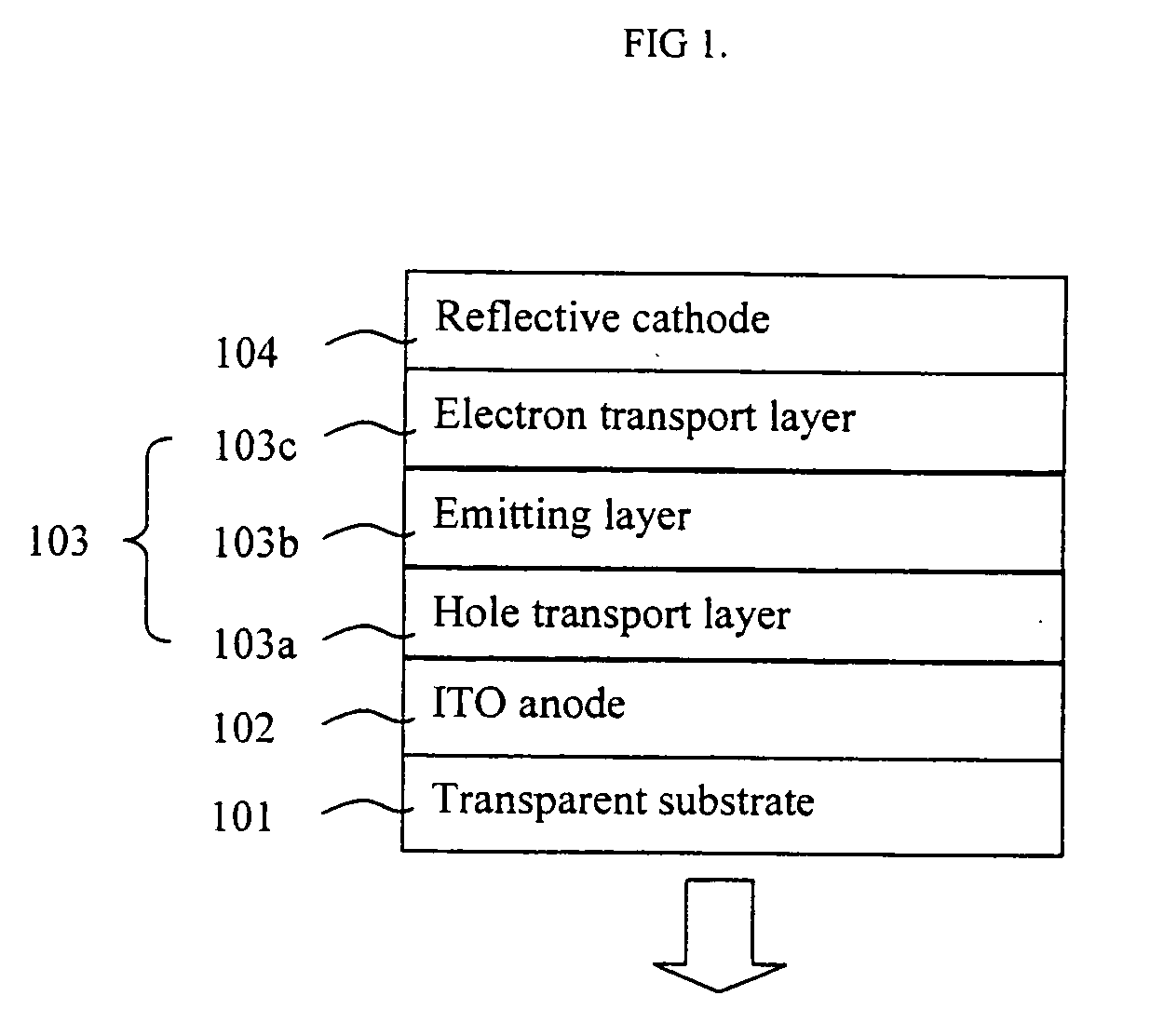Metallic anode treated by carbon tetrafluoride plasma for organic light emitting device
a technology of carbon tetrafluoride and organic light, which is applied in the direction of discharge tube luminescnet screens, discharge tube/lamp details, electric discharge lamps, etc., can solve the problems of 80% of generated light still unavailable for viewing, complicated structure, and high cost of fabrication, so as to improve the ability of the carrier, facilitate the fabrication of microcavities, and simplify the structure
- Summary
- Abstract
- Description
- Claims
- Application Information
AI Technical Summary
Benefits of technology
Problems solved by technology
Method used
Image
Examples
example 1
[0038] A comparative device (1A) and a device (1B) of present invention each having an Ag anode layer were made. The Ag anodes were deposited on a 1.1 thick bare glass sheet with thickness of 60 nm. The Ag anode of the device 1B was treated by CF4 plasma in a plasma treatment chamber in accordance with the present invention. Then the following layers were deposited in the following manner from a heated boat in the vacuum chamber under a vacuum less than 1×10−6 torr:
(1) a hole-transporting layer, consisting of 140 nm NPB; and
(2) a cathode layer, consisting of 110 nm Al.
[0039]FIG. 4 shows the current voltage relationships of the devices described in Example 1A and Example 1B. The figure shows that when the Ag anode is modified by the CF4 plasma, the device shows fast-rising J-V curve and low operation driving voltage, as compared to those obtained from comparative device 1A.
example 2
[0040] A conventional bottom emitting OLED was made using ITO as the transparent anode. After routine cleaning, the ITO was treated with CF4 plasma in a plasma treatment chamber. Then, the following layers were deposited in the following sequence from a heated boat in the vacuum chamber under a vacuum of less than 1×10−6 torr:
(1) a hole-transporting layer, of 70 nm NPB;
(2) a light emitting layer, of 30 nm Alq doped with 1% C545T;
(3) a electron transport layer, of 30 nm Alq; and
(4) a cathode layer, of 1 nm LiF covered with 110 nm Al.
[0041] The device structure is Glass / ITO (75 nm) / NPB (70 nm) / Alq: 1% C545T (30 nm) / Alq (30 nm) / LiF (1 nm) / Al (110 nm).
example 3
[0042] A series of bottom emitting OLEDs of the present invention (devices 3A, 3B, 3C, 3D, and 3E), each having an Ag anode were made. The Ag anodes were deposited on a 1.1 nm thick bare glass sheet with thickness varying from 15 nm to 50 nm. The Ag anode surface was treated by CF4 plasma in a plasma treatment chamber. Then the following layers were deposited in the following sequence from a heated boat in the vacuum chamber under a vacuum less than 1×10−6 torr:
(1) a hole-transporting layer, of 50 nm NPB;
(2) a light emitting layer, of 24 nm Alq doped with 1% C545T;
(3) a electron transport layer, of 24 nm Alq; and
(4) a cathode layer, of 1 nm LiF covered with 110 nm Al.
[0043] The device structure is Glass / Ag (×nm) / NPB (50 nm) / Alq: 1% C545T (24 nm) / Alq (30 nm) / LiF (1 nm) / Al (110 nm).
[0044] The results of Examples 2 and 3 are listed in Table 1 attached hereto. Devices having a semitransparent Ag anode of present invention demonstrate a luminance efficiency that is higher than ...
PUM
 Login to View More
Login to View More Abstract
Description
Claims
Application Information
 Login to View More
Login to View More - R&D
- Intellectual Property
- Life Sciences
- Materials
- Tech Scout
- Unparalleled Data Quality
- Higher Quality Content
- 60% Fewer Hallucinations
Browse by: Latest US Patents, China's latest patents, Technical Efficacy Thesaurus, Application Domain, Technology Topic, Popular Technical Reports.
© 2025 PatSnap. All rights reserved.Legal|Privacy policy|Modern Slavery Act Transparency Statement|Sitemap|About US| Contact US: help@patsnap.com



